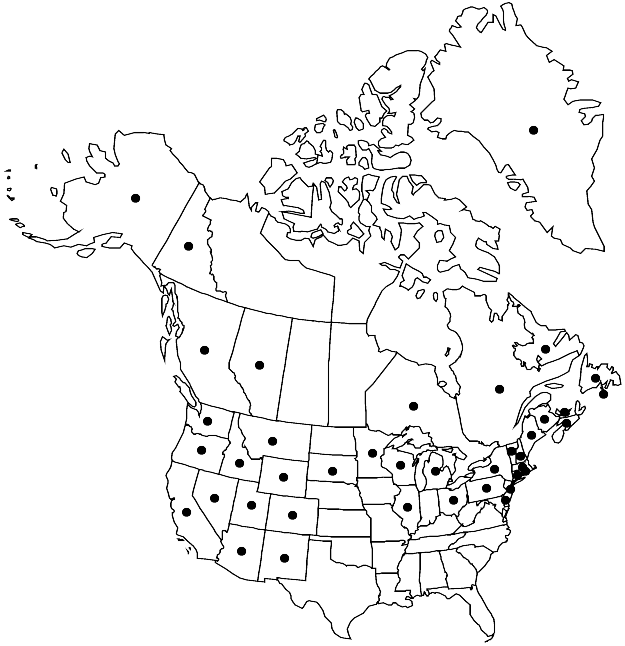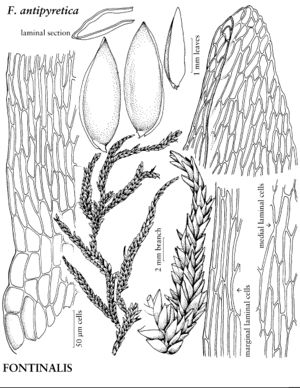Fontinalis antipyretica
Sp. Musc. Frond., 298. 1801.
Plants to 40 cm, yellow-red, yellowish green, green, dark green, or brown. Stems slender to occasionally robust, rigid; stem and branch apices swollen, flaccid, short-attenuate, sharply angled; axillary hairs to 820 µm, 6–10 cells, basal cell quadrate, red, distal cells long-cylindric, hyaline. Leaves monomorphic, imbricate to erect-appressed when dry, erect to erect-spreading in 3 ranks when moist, ovate, oblong-ovate, ovate-lanceolate, or suborbiculate, keeled and conduplicate, concave, variously curved along keel from insertion to apex, 2–8 mm; margins occasionally broadly reflexed on one side proximally; apex acute, broadly acute, or rounded obtuse; medial laminal cells 100–150 × 12–18 µm. Perigonia with leaves 1.2–1.4 mm. Perichaetia with leaves oval to suborbiculate, 2–3 mm, apex obtuse. Seta 0.2–0.3 mm. Capsule immersed to slightly emergent, ovoid to subcylindric, 2–2.7 mm; operculum obtuse-conic, 0.7–1.5 mm; endostome trellis perfect. Calyptra 1.3–1.6 mm. Spores 14–20 µm.
Habitat: Rock, sticks, logs, roots in streams, ponds, pools, ditches, swamps, floodplains, seasonally dry
Elevation: low to high elevations (0-3300 m)
Distribution

Greenland, St. Pierre and Miquelon, Alta., B.C., N.B., Nfld. and Labr., N.S., Ont., P.E.I., Que., Yukon, Alaska, Ariz., Calif., Colo., Conn., Del., Idaho, Ill., Maine, Mass., Mich., Minn., Mont., Nev., N.H., N.J., N.Mex., N.Y., Ohio, Oreg., Pa., R.I., S.Dak., Utah, Vt., Wash., Wis., Wyo., Europe, Asia, n, s Africa, Atlantic Islands (Iceland).
Discussion
Fontinalis antipyretica is stenotypic in eastern North America, where most collections conform to the gigantea expression that differs in its robust size and broad, overlapping leaves strongly curved along the keel. Most atypical western plants are variations on the oreganensis expression: medium-sized plants, weakly keeled stem leaves straight to slightly bent along the keel, apices frequently concave or plane and subobtuse or obtuse, and branch leaves occasionally concave or plane. The oreganensis expression is common along the west coast, but occurs sporadically throughout the range of the species. Fontinalis howellii and the oreganensis expression of F. antipyretica sometimes intergrade; both have stem leaves with keels typically straight beyond the basal curve and concave branch leaves. Fontinalis howellii differs in having larger plants; an abrupt transition from stem to branch leaf form; long, slender branch leaves; and loosely terete-foliate stem or branch apices that when dry lack the swollen, triangular appearance of stem or branch apices in F. antipyretica. The gracilis expression is slender (leaves 2–4 mm), loosely foliate, with lax to flaccid stems and weakly keeled (often concave) leaves. Plants of F. antipyretica found in swiftly moving streams often have leaves completely split along the keel and can be mistaken for F. hypnoides.
Selected References
None.
